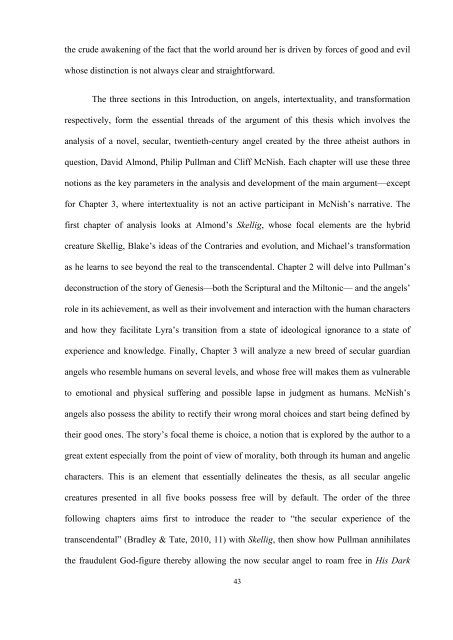The secular angel in contemporary children's literature: David ...
The secular angel in contemporary children's literature: David ...
The secular angel in contemporary children's literature: David ...
Create successful ePaper yourself
Turn your PDF publications into a flip-book with our unique Google optimized e-Paper software.
the crude awaken<strong>in</strong>g of the fact that the world around her is driven by forces of good and evil<br />
whose dist<strong>in</strong>ction is not always clear and straightforward.<br />
<strong>The</strong> three sections <strong>in</strong> this Introduction, on <strong>angel</strong>s, <strong>in</strong>tertextuality, and transformation<br />
respectively, form the essential threads of the argument of this thesis which <strong>in</strong>volves the<br />
analysis of a novel, <strong>secular</strong>, twentieth-century <strong>angel</strong> created by the three atheist authors <strong>in</strong><br />
question, <strong>David</strong> Almond, Philip Pullman and Cliff McNish. Each chapter will use these three<br />
notions as the key parameters <strong>in</strong> the analysis and development of the ma<strong>in</strong> argument—except<br />
for Chapter 3, where <strong>in</strong>tertextuality is not an active participant <strong>in</strong> McNish’s narrative. <strong>The</strong><br />
first chapter of analysis looks at Almond’s Skellig, whose focal elements are the hybrid<br />
creature Skellig, Blake’s ideas of the Contraries and evolution, and Michael’s transformation<br />
as he learns to see beyond the real to the transcendental. Chapter 2 will delve <strong>in</strong>to Pullman’s<br />
deconstruction of the story of Genesis—both the Scriptural and the Miltonic— and the <strong>angel</strong>s’<br />
role <strong>in</strong> its achievement, as well as their <strong>in</strong>volvement and <strong>in</strong>teraction with the human characters<br />
and how they facilitate Lyra’s transition from a state of ideological ignorance to a state of<br />
experience and knowledge. F<strong>in</strong>ally, Chapter 3 will analyze a new breed of <strong>secular</strong> guardian<br />
<strong>angel</strong>s who resemble humans on several levels, and whose free will makes them as vulnerable<br />
to emotional and physical suffer<strong>in</strong>g and possible lapse <strong>in</strong> judgment as humans. McNish’s<br />
<strong>angel</strong>s also possess the ability to rectify their wrong moral choices and start be<strong>in</strong>g def<strong>in</strong>ed by<br />
their good ones. <strong>The</strong> story’s focal theme is choice, a notion that is explored by the author to a<br />
great extent especially from the po<strong>in</strong>t of view of morality, both through its human and <strong>angel</strong>ic<br />
characters. This is an element that essentially del<strong>in</strong>eates the thesis, as all <strong>secular</strong> <strong>angel</strong>ic<br />
creatures presented <strong>in</strong> all five books possess free will by default. <strong>The</strong> order of the three<br />
follow<strong>in</strong>g chapters aims first to <strong>in</strong>troduce the reader to “the <strong>secular</strong> experience of the<br />
transcendental” (Bradley & Tate, 2010, 11) with Skellig, then show how Pullman annihilates<br />
the fraudulent God-figure thereby allow<strong>in</strong>g the now <strong>secular</strong> <strong>angel</strong> to roam free <strong>in</strong> His Dark<br />
43
















